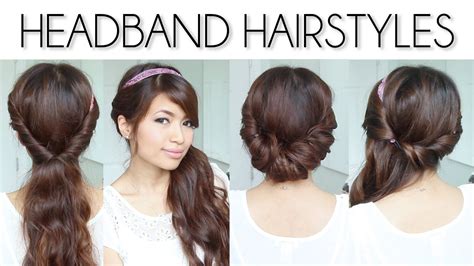Accessorizing with headbands is an effortless way to elevate your everyday look. From bohemian chic to classic elegance, the possibilities are endless.

Why Headbands Rule
- Versatile: Headbands complement all hair types and textures, from long and flowing to short and sassy.
- Time-Saving: Create stunning hairstyles in minutes with minimal effort.
- Protective: Headbands can prevent hair breakage and protect it from heat damage.
1. Knotted Crown
- Section your hair into two equal parts at the crown.
- Tie each part into a knot.
- Cross the knots over each other and tie them again.
- Secure the ends with bobby pins.
2. Bowtiful Braided Bun
- Braid a section of hair from the front to the back of your head.
- Pull the braid through the center of a hair tie and secure it.
- Wrap the remaining braid around the base of the bun and tie it.
- Slide a headband over the bun to conceal the hair tie.
3. Halo Braid with Embellished Headband
- Braid your hair into a halo braid, starting at the nape of your neck and ending at the crown.
- Secure the ends of the braid with bobby pins.
- Add an embellished headband over the braid.
- Experiment with different headband styles: Velvet, metallic, studded, and floral headbands can complement various outfits and occasions.
- Match your headband to your hair color: A headband that complements your hair color can create a cohesive look.
- Use bobby pins for extra security: Bobby pins can help keep your headband in place, especially in windy conditions.
- Overcrowding your head: Avoid wearing multiple headbands at once, as it can look cluttered and distracting.
- Using the wrong size headband: Too-tight headbands can cause headaches, while too-loose headbands may slip off.
- Styling with dirty hair: Headbands can highlight dirty hair, so make sure your hair is clean and well-maintained before accessorizing.
- Protect from skin irritation: Headbands can prevent hair from rubbing against the skin, reducing the risk of irritation.
- Reduce headaches: Some people experience relief from headaches when wearing a headband, especially a soft and stretchy one.
- Promote hair growth: Headbands that apply gentle pressure on the scalp may stimulate blood flow, promoting hair growth.
Headwearnation encompasses the global movement of people using headbands to express their creativity and individuality.
Table 1: Headband Types for Different Hair Textures
| Hair Texture | Recommended Headband Types |
|---|---|
| Fine | Thin, velvet headbands |
| Medium | Medium-width, fabric headbands |
| Coarse | Wide, metallic or embellished headbands |
| Curly | Padded or flexible headbands |
Table 2: Headband Styles for Different Occasions
| Occasion | Recommended Headband Styles |
|---|---|
| Casual | Velvet, fabric, or studded headbands |
| Dressy | Embellished, metallic, or floral headbands |
| Work | Classic, leather, or knot-detail headbands |
| Sports | Sweat-wicking, elastic headbands |
Table 3: Headband Myths vs. Facts
| Myth | Fact |
|---|---|
| Headbands damage hair | Headbands can protect hair from breakage and heat damage when used correctly. |
| Headbands are only for long hair | Headbands can enhance short hair by adding volume and texture. |
| Headbands cause headaches | Headbands can actually relieve headaches for some people. |
Table 4: Creative Applications for Headbands
| Application | Headband Type |
|---|---|
| Neck warmer | Thin, stretchy headbands |
| Yoga strap | Wide, fabric headbands |
| Jewelry holder | Embellished or braided headbands |
| Purse organizer | Printed or textured headbands |
